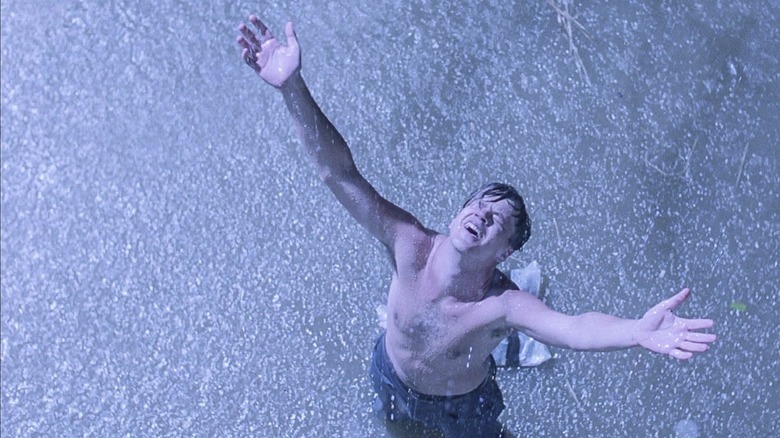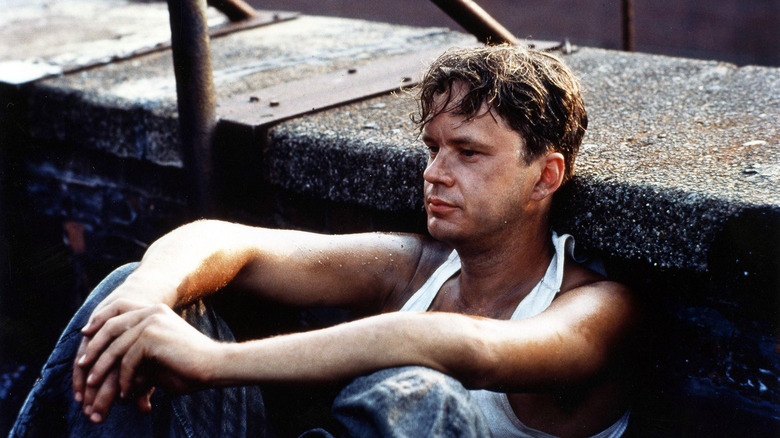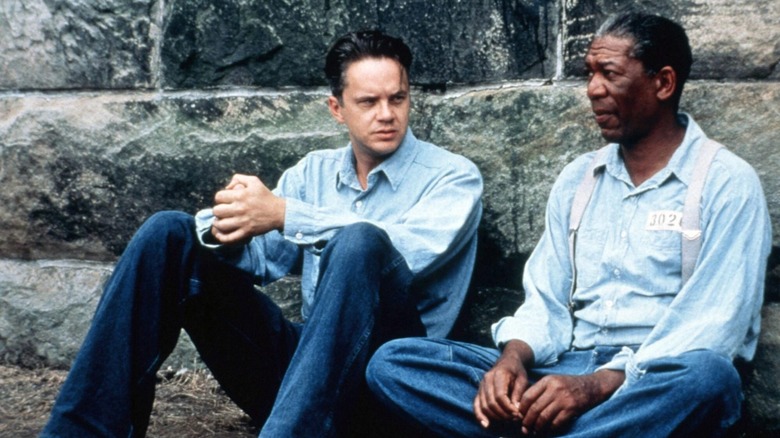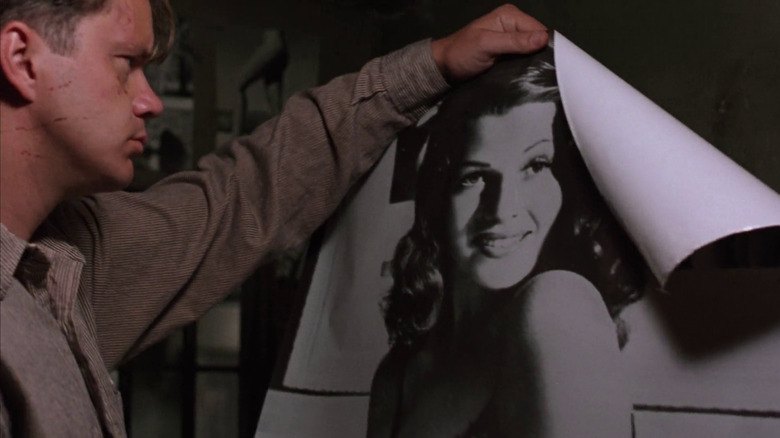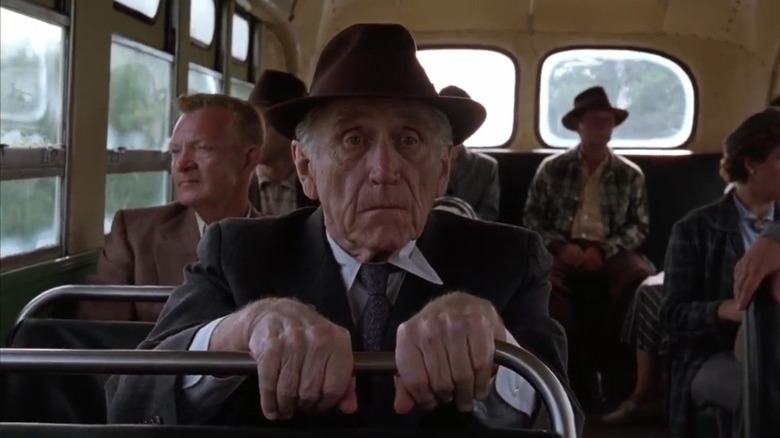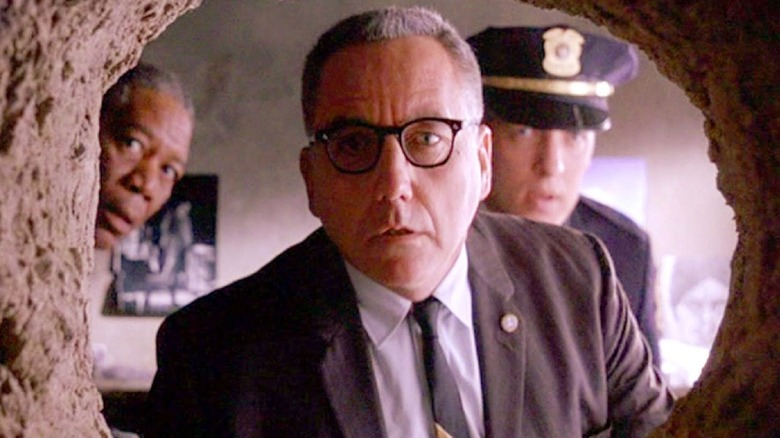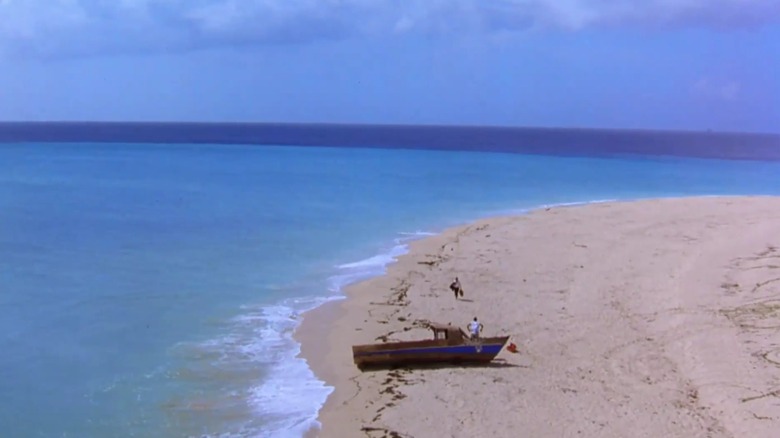The Shawshank Redemption Ending Explained: Get Busy Living, Or Get Busy Dying
Any wildly popular movie eventually attracts people who want to take it down a peg or two, and it has become fashionable in recent years to argue that "The Shawshank Redemption" is overrated. Its detractors often claim it is too slow, sentimental, cliched, and far-fetched, with a glaring plot hole that is ridiculously obvious once you know it's there.
You can make a case for all of those points, yet I'd argue they are also part of why the movie became such cinematic comfort food in the first place. The meandering, episodic nature of "Shawshank" gives room for the friendship between its two main characters to develop, as well as provide adequate screen time for the excellent supporting cast to shine. Despite its darker elements (brutal beatings, gang rape, corruption, murder) it is resolutely heartwarming with uplifting themes of friendship and hope, a wholesome Sunday afternoon film that mixed generations can enjoy together. The prison movie cliches you would expect – kindly old-timers, sadistic guards, daring escapes – are all present, part of what makes it so reassuring. After all, this isn't Steve McQueen's "Hunger" with a three-minute money shot of a guard sweeping p**s down a hallway. It has bad stuff, but it's cozy.
Some have interpreted Andy as a messiah-like figure and Christian analogies are available, but the film is more interested in the human spirit in general. Beyond the surface-level tale of a man in a dire situation never giving up hope, that theme can easily be extrapolated to everyday life as encouragement to never quit on your dreams or life in general. It might not be hip to admit loving "Shawshank," but it's easy to see why Tim Robbins has encountered people all over the world who say the film changed their life.
Why is The Shawshank Redemption so Popular?
I don't have any evidence, but I'm willing to bet that anywhere you go in the western world, 8 out of 10 people in your immediate vicinity absolutely adore "The Shawshank Redemption." While the film rarely troubles lists compiled by more highbrow critics, it frequently ranks towards the top of public polls and has occupied the first position of IMDb's Top 250 since 2008 when it knocked "The Godfather" off its perch. It is the very definition of a popular classic.
For an almost universally loved film, "Shawshank" made a very slow start when it was released in 1994. Critics praised it, but in the year of "Forrest Gump" and "Pulp Fiction," nobody went to see it. It only made $16 million against a $25 million budget on its initial theatrical run. Thanks to rentals and repeated screenings on cable, it did a modern-day "It's a Wonderful Life," becoming staple feel-good fare for millions.
It's not easy to pinpoint one specific thing that makes "Shawshank" such captivating viewing, although its strengths are many. The performances are excellent across the board and it's nicely shot by the great Roger Deakins. Thomas Newman's score stays just the right side of mawkish and it is competently directed by Frank Darabont, in his feature directorial debut. I think the key aspect to its rewatchability is Darabont's screenplay, adapted from Stephen King's novella "Rita Hayworth and the Shawshank Redemption." It is carefully layered in a way that all the details set up early in the movie pay off so satisfyingly at the end. The good guys win and the bad guys get their comeuppance, but it is so beautifully put together that it is still rewarding after repeat viewing. Let's take a look at some of those key elements.
So What Happens in The Shawshank Redemption Again?
Our story opens in 1947 as banker Andy Dufresne (Tim Robbins) is sentenced to a double life sentence for murdering his wife and her lover. Sent to the imposing Shawshank State Prison, he keeps to himself at first, but gradually becomes friends with Ellis "Red" Redding (Morgan Freeman), another lifer who serves as the prison's smuggler. Meanwhile, Andy is preyed upon by a vicious gang of rapists known as "the Sisters," led by Boggs (Mark Rolston).
Andy acquires a rock hammer from Red for his hobby of shaping stones, and a poster of Rita Hayworth. Later, when Andy has settled in with Red and his friends, he overhears Hadley (Clancy Brown), the brutal captain of the prison guards, complaining about his finances. Andy dares to offer his services, in exchange for a few cold beers for his pals.
Soon Andy attracts the attention of Warden Norton (Bob Gunton), who also needs help balancing his books. Norton installs Andy in the library alongside old-timer Brooks (James Whitmore), where Andy helps every screw in the prison with financial matters and launders money for the warden. Andy uses his favor with Norton to improve the facilities for his fellow cons, lobbying the state for funds for more books.
Andy takes a shine to newcomer Tommy (Gil Bellows), a likable young man in for burglary. Now a seasoned inmate, Andy takes Tommy under his wing, helping him study for his exams. Tommy reveals that a cellmate in another prison boasted about killing Andy's wife and lover, giving Andy hope of an appeal. Norton has no intention of letting Andy go free, sending him to solitary confinement and ordering Hadley to shoot Tommy, making it look like an escape attempt.
Seemingly at an all-time low, Andy talks to Red about his dreams of living by the ocean in Mexico, making Red promise to find a certain field in Maine if he ever gets out. That night, Red fears that Andy is contemplating suicide after he procured a length of rope from another inmate. But Andy has other plans.
The Rock Hammer and Rita Hayworth
Red is dubious when Andy asks him to obtain a rock hammer for shaping rocks, concerned that Andy might use it to escape or harm someone. His worries are laid to rest when he actually sees the dinky tool, and warns Andy that he will lose the hammer if the guards ever find it. Next, Andy requests better rocks for making chess pieces and, during a screening of "Gilda," Rita Hayworth herself.
After leaving the show, Andy is savagely beaten by Boggs and the Sisters, spending a month in the infirmary. In retaliation, Hadley pays Boggs a little visit, after which the creep never walks again. On his return from the infirmary, Andy gets a nice welcome home present from the boys – a bunch of rocks to carve, and a large poster of Rita Hayworth.
When Andy's reputation for solid financial advice reaches the warden, Norton visits him during a random cell toss. He finds Andy reading his bible, and they trade favorite verses while Hadley rummages through Andy's stuff. He finds Andy's shaped stones and Norton disapproves of the poster, but there is no sign of the rock hammer. We know Andy has it in the cell because we see him carving a chess piece and etching his name on the wall with it. Where could he have hidden it?
Satisfied with Andy and prepared to overlook the few items of "contraband" in his cell, Norton almost forgets to hand back the bible as he leaves. He then passes it back through the bars with a parting piece of advice: "Salvation lies within."
This is one of the big details that pays off so wonderfully, along with the true purpose of the poster. The film doesn't draw too much attention to the wall art, presenting it as a way of marking the passage of time, from the mid-'40s when Andy is first incarcerated, through the '50s where Marilyn Monroe takes Rita's place, through to the '60s and Raquel Welch in her iconic fur bikini.
Brooks and Red's Parole
One of the most heartbreaking scenes in "The Shawshank Redemption" follows old-timer Brooks as he is released on parole after more than 50 years, and his struggles adapting to the outside world. It's a small but important part for veteran actor Whitmore, who neatly outlines his character in a few earlier scenes, mostly feeding his pet bird and pushing the library cart around. The scene plays like a mini-movie of its own, taking us beyond the walls of Shawshank for the first time since the opening moments.
The narration switches from Red to Brooks in this segment, in the form of a letter to the fellas back in Shawshank as he describes his lonely, anxious life in a world he is completely out-of-touch with, living in a halfway house and bagging groceries at the local supermarket. Tired, frightened, and unable to adapt, Brooks carves his name into a beam in his room and hangs himself.
This episode would be powerful enough on its own, but it also sets up the later scene after Andy's escape when Red finally receives parole. Red has already admitted to Andy that he doesn't think he can make it on the outside after spending most of his life in Shawshank, and we fear a similar fate might await him. Just to reiterate the point, Red finds himself living in the same room where Brooks met his end and also working as a packing assistant. It's a joyless existence, and Red considers committing a crime to get back inside. But then he spots a compass in a pawn shop window and remembers his promise to Andy.
Andy's Final "Screw You" to The Screws...
If Andy is something of a cipher, that is because Darabont's screenplay withholds vital information from the viewer until after he has made his seemingly miraculous escape. The morning after Red fears Andy might commit suicide, his friend is gone. Norton questions Red in Andy's cell, getting increasingly irate until he throws a stone at the poster on the wall ... and it passes right through. Suddenly everything becomes clear, with help from Red's voice-over and a flashback sequence. We learn that all they found of Andy was his prison clothes, a bar of soap, and what was left of the rock hammer, worn down to a nub, much to Red's astonished amusement:
"I remember thinking it would take a man 600 years to tunnel through the wall with it. Old Andy did it in less than 20."
The flashback reveals that while Andy was carving his name with the rock hammer many years before, a lump of plaster fell out of the cell wall, prompting the idea of a tunnel. That's why the poster was a necessity, to hide his work in progress and provide cover as he chiseled away, night after night, before discarding the rubble in the prison yard.
Not content with just escaping, Andy also has revenge planned for Norton and Hadley. When Norton opens the safe for Andy to put away the incriminating ledger, Andy switches it for his bible. Then, when Norton gives him his suit for the laundry and his shoes for shining, Andy steals them, wearing the suit under his prison uniform and leaving his old brown footwear in place of Norton's. As for the rope, he uses it to tie a waterproof bag to his ankle while he climbs through the tunnel, containing Norton's clothes and a few other items.
Once cleaned up and dressed in Norton's clothes, his next step is to visit several banks and withdraw Norton's dodgy money, which he'd stashed away for the warden over the years under a false name. He then sends the incriminating ledger to the local newspaper, which runs a story of corruption and murder at Shawshank. As the cops come for Norton, he discovers the final cherry on top from Andy – a thank you note written inside the bible, along with a rock hammer-shaped hole cut in the pages. With access to hundreds of books, Andy could have switched the ledger with any number of titles, but he wanted Norton to know both how he did it, and that the warden held his method of escape in his very hands. It's the perfect kiss-off; Norton shoots himself and Hadley is arrested, while Andy spirits himself away with a life-changing amount of money to Mexico.
Red's Treasure Hunt & Reunion
Darabont's original version of "The Shawshank Redemption" ended on an ambiguous note, much like Stephen King's novella, with Red setting out on a bus to Mexico but not revealing whether he made it or not. Castle Rock producer Liz Glotzer proposed a more conclusive ending, with Andy and Red reuniting on that gorgeous Mexican beach, which Darabont felt was too sappy. Glotzer was insistent (via Vanity Fair):
"If what you intend is that they're going to get together, why not give the audience the pleasure of seeing them?"
The ending we have today is a little sentimental, and it also relies on Red remembering everything Andy told him in the prison yard; the name of the town, Zihuatanejo, and the details of the treasure hunt he lays out. He makes Red promise to find a field in Buxton, Maine, with an oak tree by an old stone wall. It's a special place for Andy because it was where he proposed to his wife. There, Red will find a rock that doesn't belong in a Maine field – a chunk of obsidian. Red locates it and finds an old tobacco tin hidden underneath with a letter from Andy and some money to fund his travel expenses if he wants to join him down in Mexico.
Luckily, Red remembers the name of the place and sets off, skipping parole and heading for the border. He finds Andy on a beautiful stretch of beach, working on an old boat. They embrace as the credits roll, and we're left with little doubt that they will spend the rest of their days living peacefully together by the ocean. Sappy, sentimental? Maybe, but Andy and Red deserve it.
